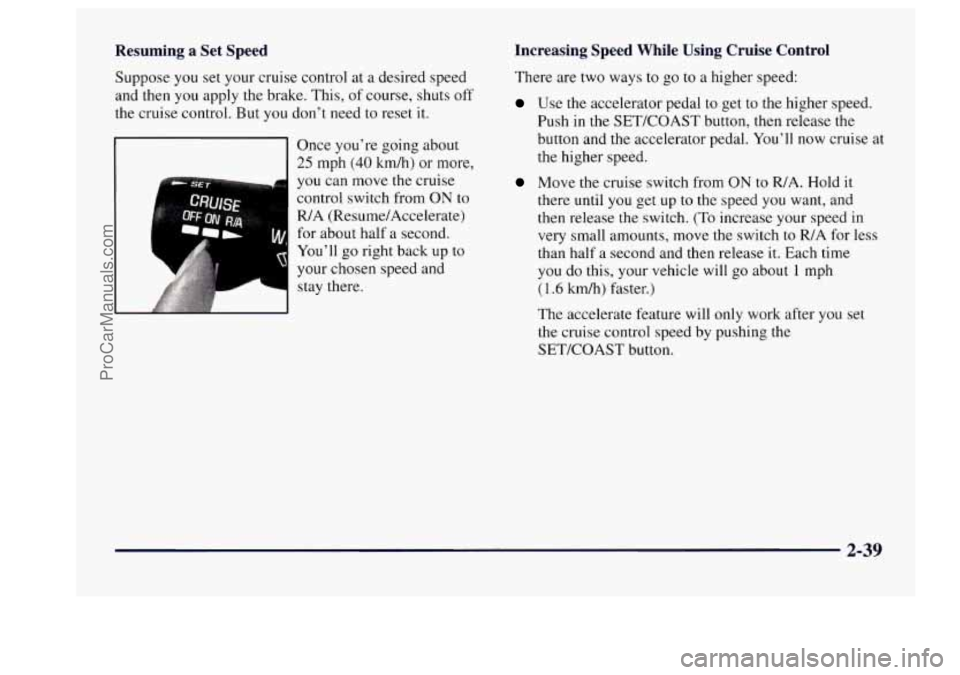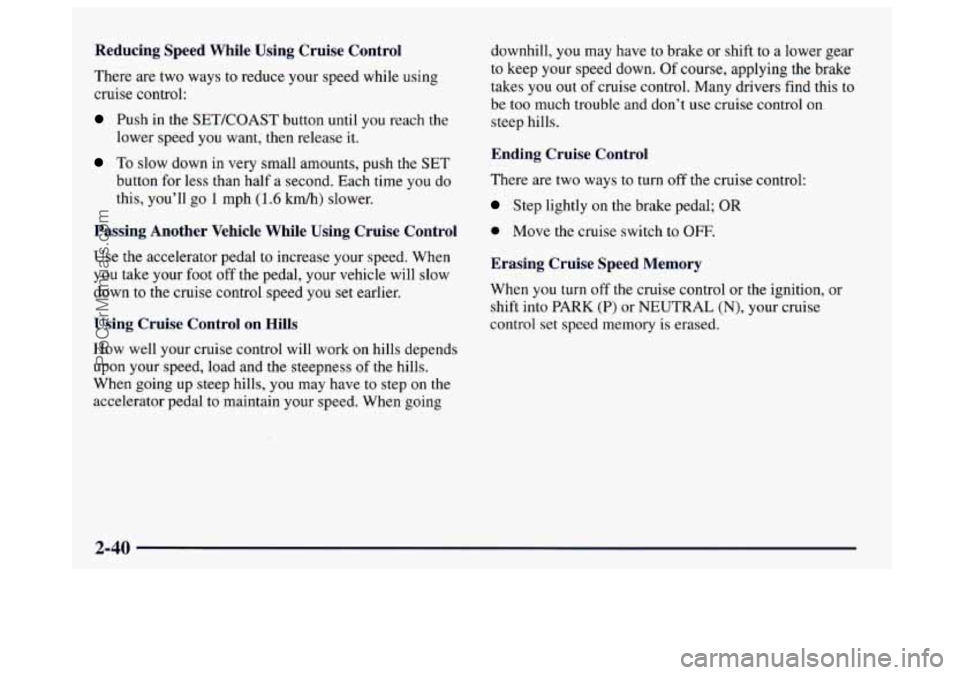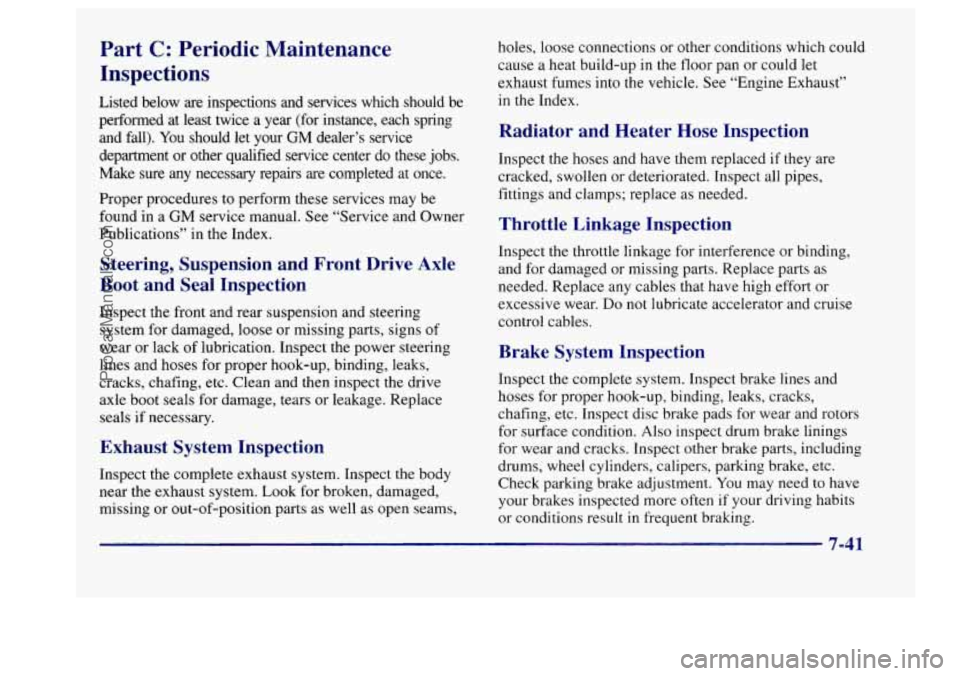Page 110 of 406
Turn SignaUMultifunction Lever
L
Lr
The lever on the left side of the steering column
includes your:
Turn Signal and Lane Change Indicator
0 Headlamp HighLow Beam
Windshield Wipers
0 Windshield Washer
0 Cruise Control
0 Flash-to-Pass
Turn Signal and Lane Change Indicator
The turn signal has two upward (for right) and two
downward (for left) positions. These positions allow
you
to signal a turn or a lane change.
To signal a turn, move the lever all the way up or down.
When the
turn is finished, the lever will return automatically.
An arrow on the instrument
panel will flash in the
direction of the turn
or
lane change.
2-34
ProCarManuals.com
Page 113 of 406
Windshield Washer
At the top of the multifunction lever, there’s a paddle with
the word
PUSH on it. To spray washer fluid on the
windshield, push the paddle. The wipers will run
for
several sweeps and then either stop or return to your preset
speed. See “Windshield Washer Fluid” in the Index.
LOW WASH
The LOW WASH light on
your instrument panel
cluster will glow when the
fluid level
is low.
I
In freezlng weather, don’t use your washer until
the windshield is warmed. Otherwise the washer
fluid can form ice
on the windshield, blocking
your vision.
Cruise Control (Option)
With cruise control, you can maintain a speed of about
25 mph (40 km/h) or more without keeping your foot on
the accelerator. This can really help
on long trips. Cruise
control does
not work at speeds below about 25 mph
(40 km/h).
2-37
ProCarManuals.com
Page 114 of 406
When you apply your brakes, the cruise control
shuts
off.
/tl CAC LION:
Setting Cruise Control
Cruise control can be dangerous where you
can't
drive safely at a steady speed. So,
don't use your cruise control on winding
roads or in heavy traffic.
slippery roads. On such roads, fast changes
in tire traction can cause needless wheel
spinning,
and you could lose control. Don't
use cruise control on slippery roads.
Cruise control can be dangerous on
A CAUTION:
If you leave your cruise control switch on when
you're not using cruise, you might hit a button
and
go into cruise when you don't want to. You
could
be startled and even lose control. Keep the
cruise control switch
off until you want to use it.
1. Move the cruise control switch to ON.
2. Get up to the speed you want.
3. Push in the SETKOAST
button at the end
of the
lever
and release it. The
CRUISE light on the
instrument panel will
come on.
'1 1
4. Take your foot off the accelerator pedal.
2-38
ProCarManuals.com
Page 115 of 406

Resuming a Set Speed
Suppose you set your cruise control at a desired speed
and then you apply the brake. This,
of course, shuts off
the cruise control.
But you don’t need to reset it.
Once you’re going about
25 mph (40 km/h) or more,
you can move the cruise
control switch from
ON to
R/A (Resume/Accelerate)
for about half
a second.
You’ll
go right back up to
your chosen speed and
stay there.
Increasing Speed While Using Cruise Control
There are two ways to go to a higher speed:
Use the accelerator pedal to get to the higher speed,
Push in the SETKOAST button, then release the
button and
the accelerator pedal. You’ll now cruise at
the higher speed.
Move the cruise switch from ON to R/A. Hold it
there until you get up
to the speed you want, and
then release the switch. (To increase your speed in
very small amounts, move the switch to R/A for less
than half
a second and then release it. Each time
you do
this, your vehicle will go about 1 mph
( 1.6 kmk) faster.)
The accelerate feature will only work after you set
the cruise control speed by pushing the
SETKOAST button.
2-39
ProCarManuals.com
Page 116 of 406

Reducing Speed While Using Cruise Control
There are two ways to reduce your speed while using
cruise control:
Push in the SETKOAST button until you reach the
To slow down in very small amounts, push the SET
button for less than half a second. Each time you do
this, you’ll go
1 mph (1.6 km/h) slower.
lower speed
you want, then release
it.
Passing Another Vehicle While Using Cruise Control
Use the accelerator pedal to increase your speed. When
you take your foot off the pedal, your vehicle will slow
down to
the cruise control speed you set earlier.
Using Cruise Control on Hills
How well your cruise control will work on hills depends
upon your speed, load and the steepness
of the hills.
When going up steep hills, you may have to step on the
accelerator pedal to maintain your speed. When going downhill,
you may
have to brake or shift to a lower gear
to keep your speed down. Of course, applying the brake
takes you
out of cruise control. Many drivers find this to
be too much trouble and don’t use cruise control on
steep hills.
Ending Cruise Control
There are two ways to turn off the cruise control:
Step lightly on the brake pedal; OR
0 Move the cruise switch to OFF.
Erasing Cruise Speed Memory
When you turn off the cruise control or the ignition, or
shift into PARK
(P) or NEUTRAL (N), your cruise
control
set speed memory is erased.
2-40
ProCarManuals.com
Page 143 of 406
Cruise Light
The CRUISE light comes
on whenever you
set your
cruise control.
See “Cruise
CRUISE
Control” in the Index.
Service Vehicle Soon Light
SERVICE VEHICLE
SOON
This light will come on if
you have certain
non-emission related
vehicle problems. These
problems may
not be obvious and may affect
vehicle performance or durability. Consult
a qualified
Buick dealership for necessary repairs to maintain top
vehicle performance. The light will come on briefly
when your ignition is turned
on to show that it is
working properly.
Low Washer Fluid Warning Light
This light will come on
when your windshield
washers are working and
the
fluid container is low. The
light will also come
on
briefly when your ignition
is turned on
to show that it
is working properly.
2-67
ProCarManuals.com
Page 324 of 406
Circuit
Breaker
A
B
C
D
Description
Not Used
Power Windows/Sunroof
Rear Defog
Power Seats
Fuse
1
4
6
8
10
13
14
15
17
18
19
20
22
Description
Not Used
Ignition Signal
-- Hot in Run and
Start
-- PCM, BCM U/H Relay
Power Mirrors
Panel Dimming
Ignition Signal
-- Hot in Run,
Unlock and Start -- Cluster,
Powertrain Control Module, Body
Control Module
DRL Module
Interior Lamps
Door Locks
Taillamps, License Lp
Radio Heated Mirror
Cruise Control
Clusters
6-58
ProCarManuals.com
Page 371 of 406

Part C: Periodic Maintenance
Inspections
Listed below are inspections and services which should be
performed at least twice a year (for instance, each spring
and fall). You should let your
GM dealer’s service
department or other qualified service center do these jobs.
Make sure any necessary repairs are completed at once.
Proper procedures
to perform these services may be
found in a
GM service manual. See “Service and Owner
Publications” in the Index.
Steering, Suspension and Front Drive Axle
Boot and Seal Inspection
Inspect the front and rear suspension and steering
system for damaged, loose or missing parts, signs
of
wear or lack of lubrication. Inspect the power steering
lines and hoses for proper hook-up, binding, leaks,
cracks, chafing, etc. Clean and then inspect the drive
axle boot seals for damage, tears or leakage. Replace
seals if necessary.
Exhaust System Inspection
Inspect the complete exhaust system. Inspect the body
near the exhaust system.
Look for broken, damaged,
missing or out-of-position parts
as well as open seams, holes,
loose connections or other conditions which could
cause
a heat build-up in the floor pan or could let
exhaust fumes into the vehicle. See “Engine Exhaust’’
in the Index.
Radiator and Heater Hose Inspection
Inspect the hoses and have them replaced if they are
cracked, swollen or deteriorated. Inspect all pipes,
fittings and clamps; replace
as needed.
Throttle Linkage Inspection
Inspect the throttle linkage for interference or binding,
and for damaged or missing parts. Replace parts
as
needed. Replace any cables that have high effort or
excessive wear. Do
not lubricate accelerator and cruise
control cables.
Brake System Inspection
Inspect the complete system. Inspect brake lines and
hoses for proper hook-up, binding, leaks, cracks,
chafing, etc. Inspect disc brake pads for wear and rotors
for surface condition. Also inspect drum brake linings
for wear and cracks. Inspect other brake parts, including
drums, wheel cylinders, calipers, parking brake, etc.
Check parking brake adjustment. You may need to have
your brakes inspected more often
if your driving habits
or conditions result in frequent braking.
7-41
ProCarManuals.com